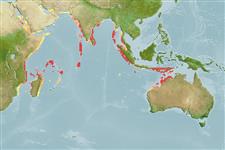>
Gobiiformes (Gobies) >
Gobiidae (Gobies) > Gobiinae
Etymology: Eviota: No etymology given, suggested by Christopher Scharpt: from Latin 'eu' for 'true' and 'iota' for anything very small, in combination 'truly very small' referring to it as being the smallest vertebrate at the time it has benn described by Jenkins (thus, making the suggestion by Scharpt plausible.; mikiae: Named for Miki Tonzuka of Bali, Indonesia, for her assistance with fish collections during the Weh Islands survey (Ref. 44113).
Environment: milieu / climate zone / depth range / distribution range
Ecologie
marien rifbewoner; diepte 6 - 25 m (Ref. 30404). Tropical
Indian Ocean: Seychelles (Amirante Islands), Chagos Archipelago, Maldives, Thailand (Andaman Sea), and Indonesia (Sumatra).
Grootte / Gewicht / Leeftijd
Maturity: Lm ? range ? - ? cm
Max length : 3.5 cm TL mannelijk / geslacht onbekend; (Ref. 30404)
Dorsale stekels (totaal): 7; Dorsale zachte stralen (totaal): 9; Anale stekels 1; Anale zachte stralen: 8. Pectoral fin rays simple; spinous dorsal fin moderately elongate in both sexes, second and third rays longest, fifth pelvic fin ray well developed, two-tenths to three-tenths length of fourth ray; cephalic sensory pore system lacking IT and PITO pores, and AITO pore single (except double in smallest paratype) and very small; posterior rays of second dorsal and anal fins elongate, forming a lanceolate shape; preserved specimens generally whitish with dark pigment along base of anal fin, extending along ventral edge of caudal peduncle; small dark spot usually present at lower caudal fin base; nostrils dark and pair of brown spots of variable intensity usually present on top of head, just behind eyes (Ref. 44113).
Inhabits rich coral reef slopes with moderate tidal currents, in small groups on large coral heads (Ref. 30404, 48637).
Levenscyclus en paargedrag
Maturiteit | Voortplanting | Paaien | Eieren | Fecunditeit | Larven
Allen, G.R., 2001. Description of two new gobies (Eviota, Gobiidae) from Indonesian seas. aqua, J. Ichthyol. Aquat. Biol. 4(4):125-130. (Ref. 44113)
Status op de Rode Lijst van het IUCN (Ref. 130435)
Gevaar voor de mens
Harmless
Gebruik door de mens
Meer informatie
Lokale namenSynoniemenMetabolismePredatorenEcotoxicologieVoortplantingMaturiteitPaaienPaaiaggregatiesFecunditeitEierenOntwikkeling van de eieren
ReferentiesAquacultuurAquacultuurprofielKweeklijnenGeneticaElectrophoresesErfelijkheidZiektesVerwerkingNutrientsMassaconversie
Tools
Speciale rapporten
Download XML
Internetbronnen
Estimates based on models
Preferred temperature (Ref.
123201): 27 - 29.3, mean 28.4 °C (based on 563 cells).
Fylogenetische diversiteitsindex (Ref.
82804): PD
50 = 0.5000 [Uniqueness, from 0.5 = low to 2.0 = high].
Bayesian length-weight: a=0.00708 (0.00333 - 0.01504), b=3.09 (2.92 - 3.26), in cm total length, based on LWR estimates for this (Sub)family-body shape (Ref.
93245).
Trofisch niveau (Ref.
69278): 3.1 ±0.3 se; based on size and trophs of closest relatives
Weerstandsvermogen (Ref.
120179): Hoog, minimale populatieverdubbelingstijd minder dan 15 maanden (Preliminary K or Fecundity.).
Fishing Vulnerability (Ref.
59153): Low vulnerability (10 of 100).
Nutrients (Ref.
124155): Calcium = 335 [145, 854] mg/100g; Iron = 1.37 [0.62, 2.92] mg/100g; Protein = 17.7 [15.6, 19.5] %; Omega3 = 0.102 [0.038, 0.257] g/100g; Selenium = 31.5 [10.7, 85.1] μg/100g; VitaminA = 111 [24, 478] μg/100g; Zinc = 3.59 [2.08, 5.80] mg/100g (wet weight);
